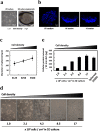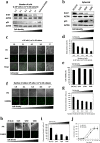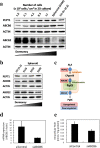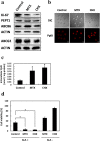Dormant cancer cells accumulate high protoporphyrin IX levels and are sensitive to 5-aminolevulinic acid-based photodynamic therapy
- PMID: 27857072
- PMCID: PMC5114660
- DOI: 10.1038/srep36478
Dormant cancer cells accumulate high protoporphyrin IX levels and are sensitive to 5-aminolevulinic acid-based photodynamic therapy
Abstract
Photodynamic therapy (PDT) and diagnosis (PDD) using 5-aminolevulinic acid (ALA) to drive the production of an intracellular photosensitizer, protoporphyrin IX (PpIX), are in common clinical use. However, the tendency to accumulate PpIX is not well understood. Patients with cancer can develop recurrent metastatic disease with latency periods. This pause can be explained by cancer dormancy. Here we created uniformly sized PC-3 prostate cancer spheroids using a 3D culture plate (EZSPHERE). We demonstrated that cancer cells exhibited dormancy in a cell density-dependent manner not only in spheroids but also in 2D culture. Dormant cancer cells accumulated high PpIX levels and were sensitive to ALA-PDT. In dormant cancer cells, transporter expressions of PEPT1, ALA importer, and ABCB6, an intermediate porphyrin transporter, were upregulated and that of ABCG2, a PpIX exporter, was downregulated. PpIX accumulation and ALA-PDT cytotoxicity were enhanced by G0/G1-phase arrestors in non-dormant cancer cells. Our results demonstrate that ALA-PDT would be an effective approach for dormant cancer cells and can be enhanced by combining with a cell-growth inhibitor.
Conflict of interest statement
SBI Pharma CO., Ltd., provided support in the form of salaries for authors M.N. and T.T., but did not have any additional role in the study design, data collection and analysis, decision to publish, or preparation of the manuscript.
Figures






Similar articles
-
Enhanced lipid metabolism induces the sensitivity of dormant cancer cells to 5-aminolevulinic acid-based photodynamic therapy.Sci Rep. 2021 Mar 31;11(1):7290. doi: 10.1038/s41598-021-86886-9. Sci Rep. 2021. PMID: 33790399 Free PMC article.
-
The inhibition of ferrochelatase enhances 5-aminolevulinic acid-based photodynamic action for prostate cancer.Photodiagnosis Photodyn Ther. 2013 Dec;10(4):399-409. doi: 10.1016/j.pdpdt.2013.03.003. Epub 2013 Apr 12. Photodiagnosis Photodyn Ther. 2013. PMID: 24284092
-
Novel potential photodynamic therapy strategy using 5-Aminolevulinic acid for ovarian clear-cell carcinoma.Photodiagnosis Photodyn Ther. 2018 Mar;21:121-127. doi: 10.1016/j.pdpdt.2017.11.013. Epub 2017 Nov 28. Photodiagnosis Photodyn Ther. 2018. PMID: 29196245
-
Targeting ABCG2 transporter to enhance 5-aminolevulinic acid for tumor visualization and photodynamic therapy.Biochem Pharmacol. 2023 Nov;217:115851. doi: 10.1016/j.bcp.2023.115851. Epub 2023 Oct 17. Biochem Pharmacol. 2023. PMID: 37858868 Free PMC article. Review.
-
5-Aminolevulinic Acid-Induced Protoporphyrin IX Fluorescence Imaging for Tumor Detection: Recent Advances and Challenges.Int J Mol Sci. 2022 Jun 9;23(12):6478. doi: 10.3390/ijms23126478. Int J Mol Sci. 2022. PMID: 35742921 Free PMC article. Review.
Cited by
-
Supported gel slab scaffolds as a three-dimensional cell-based assay platform.Analyst. 2024 Sep 9;149(18):4653-4662. doi: 10.1039/d4an00691g. Analyst. 2024. PMID: 39072359
-
Augmentation of 5-Aminolevulinic Acid Treatment of Glioblastoma by Adding Ciprofloxacin, Deferiprone, 5-Fluorouracil and Febuxostat: The CAALA Regimen.Brain Sci. 2018 Nov 22;8(12):203. doi: 10.3390/brainsci8120203. Brain Sci. 2018. PMID: 30469467 Free PMC article.
-
Photodynamic therapy induced cell cycle arrest and cancer cell synchronization: review.Front Oncol. 2023 Jul 12;13:1225694. doi: 10.3389/fonc.2023.1225694. eCollection 2023. Front Oncol. 2023. PMID: 37503319 Free PMC article. Review.
-
Metalloporphyrin Pd(T4) Exhibits Oncolytic Activity and Cumulative Effects with 5-ALA Photodynamic Treatment against C918 Cells.Int J Mol Sci. 2020 Jan 20;21(2):669. doi: 10.3390/ijms21020669. Int J Mol Sci. 2020. PMID: 31968535 Free PMC article.
-
Enhanced lipid metabolism induces the sensitivity of dormant cancer cells to 5-aminolevulinic acid-based photodynamic therapy.Sci Rep. 2021 Mar 31;11(1):7290. doi: 10.1038/s41598-021-86886-9. Sci Rep. 2021. PMID: 33790399 Free PMC article.
References
-
- Krammer B. & Plaetzer K. ALA and its clinical impact, from bench to bedside. Photochem. Photobiol. Sci. 7, 283–289 (2008). - PubMed
-
- Kennedy J. C. & Pottier R. H. Endogenous protoporphyrin IX, a clinically useful photosensitizer for photodynamic therapy. J. Photochem. Photobiol. B 14, 275–292 (1992). - PubMed
-
- Tabata K., Ogura S. & Okura I. Photodynamic efficiency of protoporphyrin IX: comparison of endogenous protoporphyrin IXinduced by 5-aminolevulinic acid and exogenous porphyrin IX. Photochem. Photobiol. 66, 842–846 (1997).
-
- Stummer W. et al.. Fluorescence-guided surgery with 5-aminolevulinicacid for resection of malignant glioma: a randomised controlledmulticentre phase III trial. Lancet Oncol 7, 392–401 (2006). - PubMed
-
- Inoue K. et al.. Comparison between intravesical and oraladministration of 5-aminolevulinic acid in the clinical bene-fit of photodynamic diagnosis for non-muscle invasive bladdercancer. Cancer. 118, 1062–1074 (2012). - PubMed
Publication types
MeSH terms
Substances
LinkOut - more resources
Full Text Sources
Other Literature Sources
Medical

